Related Research Articles
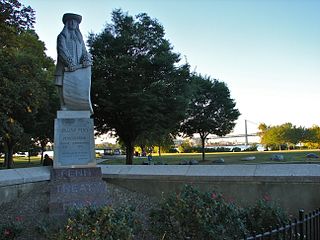
Fishtown is a neighborhood in the River Wards section of Philadelphia, Pennsylvania, United States. Located northeast of Center City Philadelphia, its borders are somewhat disputed today due to many factors, but are roughly defined by the triangle created by the Delaware River, Front Street, and York Street. Some newer residents expand the area to Lehigh Avenue to the northeast, while some older residents shrink the area to Norris Street. It is served by the Market–Frankford Line rapid transit subway/elevated line of the SEPTA system, and the historic Route 15 Girard Avenue trolley line. Fishtown has long been a largely working class Irish Catholic and Irish American neighborhood, though in recent years it has seen a large influx of young urban professionals and gentrification.

Northeast Philadelphia, nicknamed Northeast Philly, the Northeast and the Great Northeast, is a section of Philadelphia, Pennsylvania. According to the 2000 census, Northeast Philadelphia has a population of between 300,000 and 450,000, depending on how the area is defined. The Northeast is known as being home to a large and diverse working class population, including Polish, German, Jewish, Russian, African American, Brazilian, Puerto Rican, Dominican, Guatemalan, Ukrainian, Indian, Chinese, Irish, and Vietnamese neighborhoods.
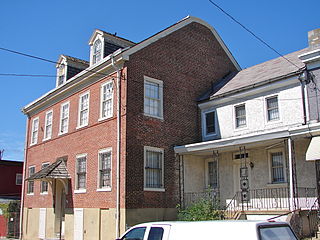
Frankford is a neighborhood in the Northeast section of Philadelphia situated about six miles (10 km) northeast of Center City. Although its borders are vaguely defined, the neighborhood is bounded roughly by the original course of Frankford Creek on the south to Castor Avenue on the northwest and southwest, to Cheltenham Avenue on the north, and to Aramingo Avenue and I-95 on the east. Adjacent neighborhoods are Bridesburg, Juniata, Northwood, Summerdale, and Wissinoming.
Roosevelt Boulevard, officially named the Theodore Roosevelt Memorial Boulevard and locally known as "the Boulevard", is a major traffic artery through North and Northeast Philadelphia. The road begins at Interstate 76 in Fairmount Park, running as a freeway also known as the Roosevelt Boulevard Extension or the Roosevelt Expressway through North Philadelphia, then transitioning into a twelve-lane boulevard that forms the spine of Northeast Philadelphia to its end at the city line.
Lawncrest is a neighborhood in the "Near" (lower) Northeast Philadelphia, Pennsylvania. The name is an amalgam of Lawndale and Crescentville, the two primary communities that make up the neighborhood. The Philadelphia Inquirer does not consider Lawncrest to be a neighborhood.

Abraham Simon Wolf Rosenbach was an American collector, scholar, and dealer in rare books and manuscripts. In London, where he frequently attended the auctions at Sotheby's, he was known as "The Terror of the Auction Room." In Paris, he was called "Le Napoléon des Livres". Many others referred to him as "Dr. R.", a "Robber Baron" and "the Greatest Bookdealer in the World".
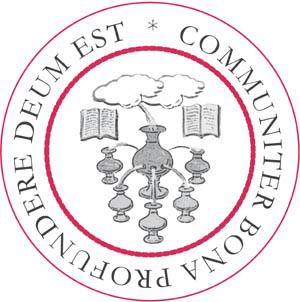
The Library Company of Philadelphia (LCP) is a non-profit organization based on Locust Street in Center City Philadelphia. Founded as a library in 1731 by Benjamin Franklin, the Library Company of Philadelphia has accumulated one of the most significant collections of historically valuable manuscripts and printed material in the United States.

The Rosenbach is a Philadelphia museum and library located within two 19th-century townhouses. Established as a testamentary gift in 1954. The historic houses contain the donated collections of Dr. Abraham Simon Wolf Rosenbach and his brother Philip H. Rosenbach. The Rosenbach offers virtual and on-site programs, including tours, Courses, Book Clubs, and a free weekly web series called Biblioventures, all inspired by its peerless collection. The Rosenbach is Philadelphia's home for Bloomsday, a festival celebrating James Joyce's Ulysses every June 16.
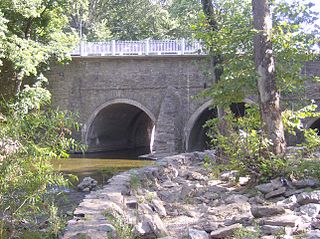
Pennypack Creek is a 22.6-mile-long (36.4 km) creek in southeastern Pennsylvania in the United States. It runs southeast through lower Bucks County, eastern Montgomery County and the northeast section of Philadelphia, before emptying into the Delaware River.
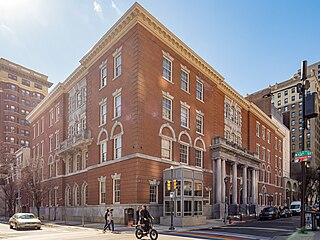
The Historical Society of Pennsylvania is a historic research facility headquartered on Locust Street in Center City Philadelphia. It is a repository for millions of historic items ranging across rare books, scholarly monographs, family chronicles, maps, press reports and varied ephemera, reaching back almost 300 years, and accessible on the society's website.

Tacony is a historic neighborhood in Northeast Philadelphia, United States, approximately 8 miles (13 km) from downtown Philadelphia. It is bounded by the east side of Frankford Avenue on the northwest, the south side of Cottman Avenue on the northeast, the north side of Robbins Street on the southwest, and the Delaware River and Interstate 95 on the southeast.

13th Street station is a SEPTA subway station in Philadelphia, Pennsylvania, located under Market Street between 13th and Juniper Streets in Center City. The station serves the Market–Frankford Line and is the eastern terminal station for all five routes of the subway–surface trolley lines.
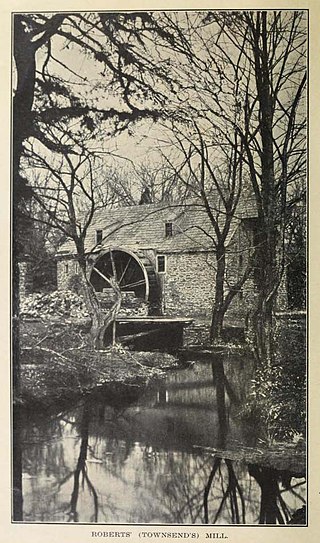
Wingohocking Creek was once a major tributary of another Philadelphia, Pennsylvania stream, Frankford Creek, which flows into the Delaware River. Frankford Creek was formed by the confluence of Wingohocking Creek and Tacony Creek. Since Wingohocking Creek is now obliterated, having been piped underground in the late 19th century, it can be confusing to look at a modern map, which shows Tacony Creek suddenly changing names "in the middle of the stream," so to speak, and becoming Frankford Creek. The point at which the name changes is near the present intersection of I and Ramona Streets, where the Wingohocking once joined the Tacony to form the Frankford Creek. What was once a major stream and the site of many mills and factories has been completely wiped off the map—all but the city's sewer maps, that is. The outlet of the Wingohocking Sewer is the largest in the Philadelphia sewer system, about 24 feet (7.3 m) high. It is visible from various points in the Juniata neighborhood and the adjoining golf course.

Oxford Circle is a neighborhood in the lower Northeast section of Philadelphia, Pennsylvania, United States. Its namesake is the much used traffic circle at Roosevelt Boulevard and Oxford Avenue. The Oxford Circle neighborhood has traditionally included the areas up to Rhawnhurst and Mayfair but does not really have a fixed boundary, other than in publications about Philadelphia which are of a public relations or informational nature.
Founded in 1869, the Historical Society of Berks County (HSBC) operates the Berks History Center as a museum and library located in Reading, Pennsylvania. The Society's mission, as described on its website, is "to focus attention on the unique local history, the vast material culture, and the diverse cultural heritage of Berks County by preserving, archiving, and promoting this material to instill in our citizens of all ages and ethnic groups an awareness of this growing treasure trove of information. This allows the HSBC to be a major cultural magnet, drawing people to our community."

Leigh Ronald Keno and Leslie Bernard Keno are American antiquarians, authors, historic car judges, preservationists and television hosts. They specialize in stoneware, early American furniture and vintage automobiles. They are widely known as appraisers on the PBS series Antiques Roadshow, for favoring preservation of antiques over restoration and for their high-energy personalities.
The Schwenkfelder Library & Heritage Center is a not-for-profit historical library, archive, and museum located in Pennsburg, Pennsylvania. Its mission is to "protect, preserve and interpret books, manuscripts and artifacts of the Schwenkfelders and the people of southeastern Pennsylvania in general and the Perkiomen Valley in particular."
St. Mark's Church is a historic church in the Frankford neighborhood of Philadelphia, Pennsylvania. It was founded in 1832 and continues today.

The Waynesboro Historical Society is an historical society founded in 1963 and based in Waynesboro, Pennsylvania. The Society's headquarters are housed in the Oller House. The society works for the preservation of landmarks and structures in the Waynesboro area and holds regular meetings, open to the public, which feature speakers on topics of local interest.

Cedar Grove Mansion, located in west Fairmount Park, was the summer residence for five generations of Philadelphia families. The house was built as a rural retreat from city life, and was originally located within the present day Frankford neighborhood of Northeast Philadelphia, about 4 mi (6.4 km) beyond the colonial-era city limits. In 1746, Elizabeth Coates Paschall purchased the property on which the house was subsequently built. Paschall was a widow with three children who had inherited her husband's dry goods business and desired a rural retreat from the city near her father's farm in Frankford. Construction of the grey stone house on a plot of 15 acres (6.1 ha) along Frankford Road began in 1748 and continued to 1750.
References
- ↑ "Guide to depositories of manuscript collections in Pennsylvania". Harrisburg, Commonwealth of Pennsylvania, Department of public instruction, Pennsylvania Historical commission. 1939.
- ↑ https://web.archive.org/web/20080819145605/http://www.northeasttimes.com/2004/0624/antiques.html Northeast Times